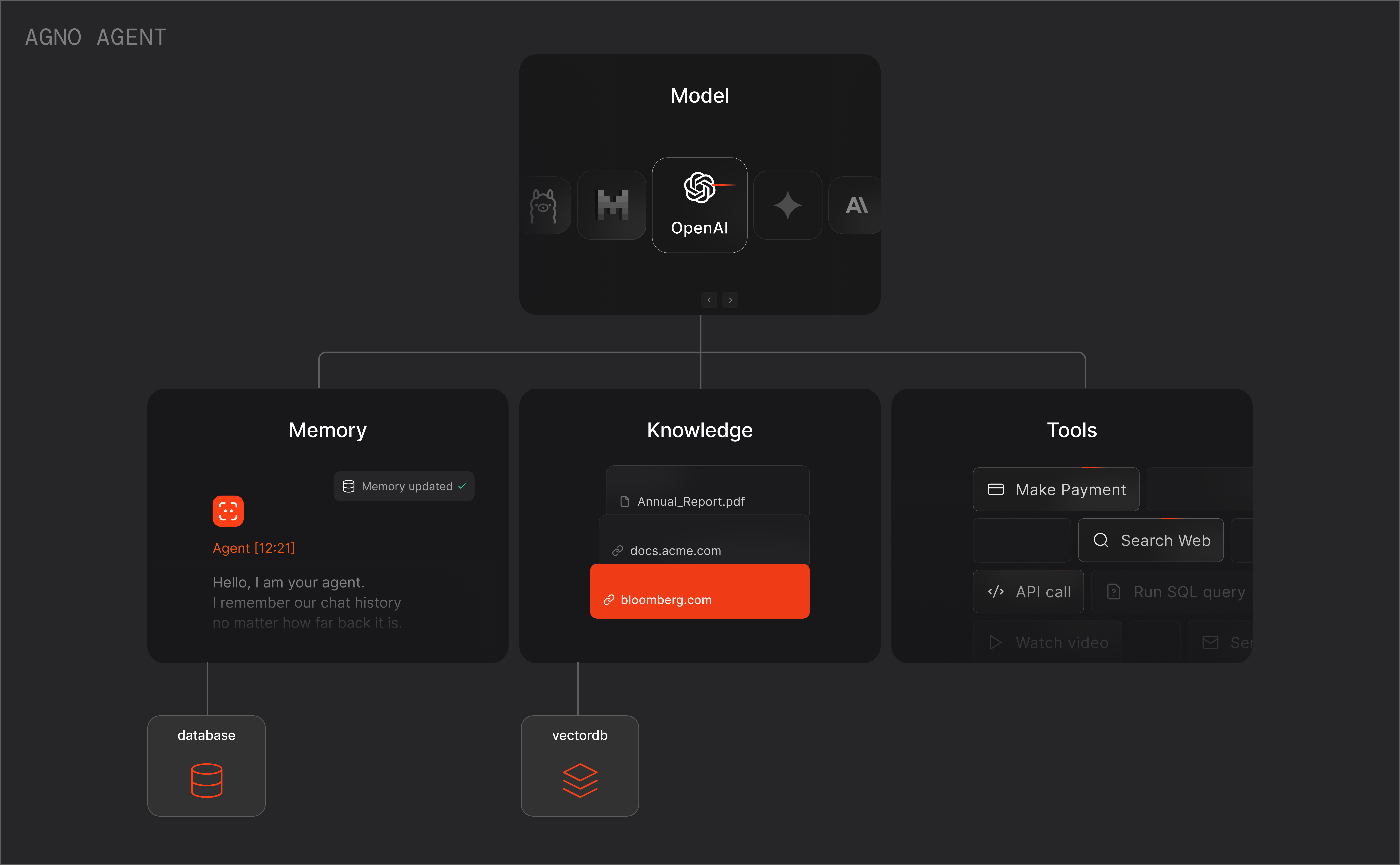エージェントは自律的に動作する AI プログラムです。従来のソフトウェアは事前にプログラムされた一連のステップに従います。エージェントは機械学習モデルを使用して行動方針を動的に決定します。エージェントのコアはモデル、ツールと指示です。
Agno : ユーザガイド : コンセプト : エージェント – 概要
作成 : クラスキャット・セールスインフォメーション
作成日時 : 07/14/2025
バージョン : Agno 1.7.3
* 本記事は docs.agno.com の以下のページを独自に翻訳した上で、補足説明を加えてまとめ直しています :
* サンプルコードの動作確認はしておりますが、必要な場合には適宜、追加改変しています。
* ご自由にリンクを張って頂いてかまいませんが、sales-info@classcat.com までご一報いただけると嬉しいです。
◆ お問合せ : 下記までお願いします。
- クラスキャット セールス・インフォメーション
- sales-info@classcat.com
- ClassCatJP
Agno ユーザガイド : コンセプト : エージェント – 概要
エージェントは自律的に動作する AI プログラムです。従来のソフトウェアは事前にプログラムされた一連のステップに従います。エージェントは機械学習モデルを使用して行動方針を動的に決定します。
エージェントのコアはモデル、ツールと指示です :
- モデル : 実行フローを制御します。推論、行動、応答のいずれかを決定します。
- ツール : エージェントがアクションを実行し、外部システムとやり取りすることを可能にします。
- 指示 (Instructions) : エージェントをプログラムし、ツールを使用したり応答する方法を教える手段です。
エージェントはまたメモリ、知識、ストレージと推論能力も備えています :
- 推論 : エージェントが応答前に「考える」ことができて、アクション (i.e. ツール呼び出し) の結果を「分析する」ことができるようにします、これは応答の信頼性と品質を向上させます。
- 知識 : エージェントが実行時に検索してより良い決定を行い正確な応答を提供できるようにするドメイン固有情報です (RAG)。知識はベクトルデータベースに保存されて、この実行時検索パターンはエージェント型 RAG/エージェント型検索と呼ばれます。
- ストレージ : セッション履歴や状態をデータベースに保存するためにエージェントが使用します。モデル API はステートレスですが、ストレージは会話を中断したところから継続することを可能にします。これはエージェントをステートフルにし、複数ターンや長期の会話を可能にします。
- メモリ : エージェントに以前のやり取りからの情報を保存して思い起こす機能を与え、ユーザの好みを学習したり応答をパーソナライズすることを可能にします。

例題 : リサーチエージェント
Ex を使用してリサーチエージェントを構築して、エージェントが特定の形式でレポートを生成するようにガイドする方法を示します。高度なケースでは、代わりに 構造化出力 を使用する必要があります。
Note : The description and instructions are converted to the system message and the input is passed as the user message. Set debug_mode=True to view logs behind the scenes.
- リサーチエージェントを作成します。
ファイル research_agent.py を作成します。
research_agent.py
from datetime import datetime from pathlib import Path from textwrap import dedent from agno.agent import Agent from agno.models.openai import OpenAIChat from agno.tools.exa import ExaTools today = datetime.now().strftime("%Y-%m-%d") agent = Agent( model=OpenAIChat(id="gpt-4o"), tools=[ExaTools(start_published_date=today, type="keyword")], description=dedent("""\ You are Professor X-1000, a distinguished AI research scientist with expertise in analyzing and synthesizing complex information. Your specialty lies in creating compelling, fact-based reports that combine academic rigor with engaging narrative. Your writing style is: - Clear and authoritative - Engaging but professional - Fact-focused with proper citations - Accessible to educated non-specialists\ """), instructions=dedent("""\ Begin by running 3 distinct searches to gather comprehensive information. Analyze and cross-reference sources for accuracy and relevance. Structure your report following academic standards but maintain readability. Include only verifiable facts with proper citations. Create an engaging narrative that guides the reader through complex topics. End with actionable takeaways and future implications.\ """), expected_output=dedent("""\ A professional research report in markdown format: # {Compelling Title That Captures the Topic's Essence} ## Executive Summary {Brief overview of key findings and significance} ## Introduction {Context and importance of the topic} {Current state of research/discussion} ## Key Findings {Major discoveries or developments} {Supporting evidence and analysis} ## Implications {Impact on field/society} {Future directions} ## Key Takeaways - {Bullet point 1} - {Bullet point 2} - {Bullet point 3} ## References - [Source 1](link) - Key finding/quote - [Source 2](link) - Key finding/quote - [Source 3](link) - Key finding/quote --- Report generated by Professor X-1000 Advanced Research Systems Division Date: {current_date}\ """), markdown=True, show_tool_calls=True, add_datetime_to_instructions=True, ) # Example usage if __name__ == "__main__": # Generate a research report on a cutting-edge topic agent.print_response( "Research the latest developments in brain-computer interfaces", stream=True ) # More example prompts to try: """ Try these research topics: 1. "Analyze the current state of solid-state batteries" 2. "Research recent breakthroughs in CRISPR gene editing" 3. "Investigate the development of autonomous vehicles" 4. "Explore advances in quantum machine learning" 5. "Study the impact of artificial intelligence on healthcare" """ - エージェントを実行します。
ライブラリのインストール
pip install openai exa-py agnoエージェントの実行
python research_agent.py
以上
